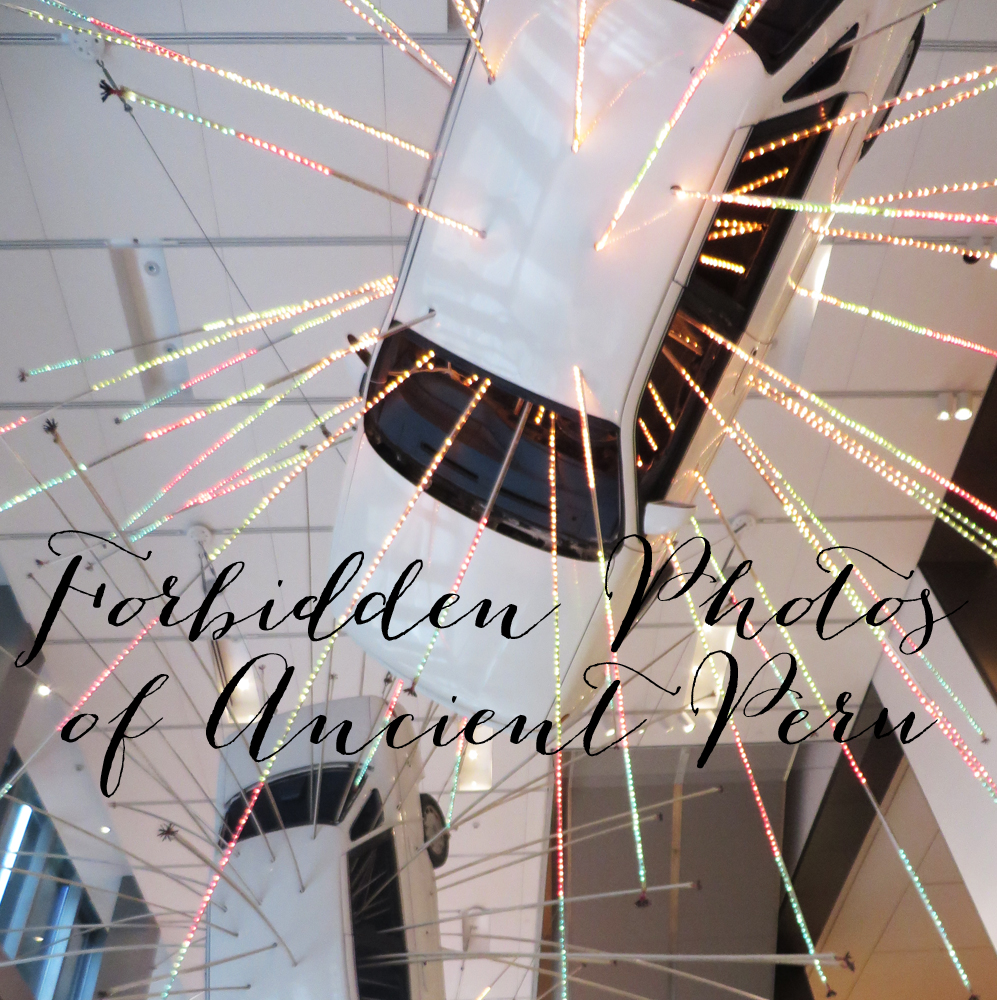 I can hear you from here. “My darling Standard Deviation, those cars are not Peruvian, ancient, or forbidden. What fresh hell is this?”
I can hear you from here. “My darling Standard Deviation, those cars are not Peruvian, ancient, or forbidden. What fresh hell is this?”
“Well,” my natural reply comes. “As those are Ford Tauruses, you are correct on all accounts. But I was able to take so few pictures of the main exhibit itself that I chose to use this as the title card instead.”
“Oh,” I hear you say. “Ok?”
Good enough.
Here are some things I don’t do as often as I’d like:
- Go see readings at Richard Hugo House
- Go to the Frye or the Henry
- Go to the Seattle Asian Art Museum
- Go to SAM
I could go on at length. But really, the list would just be a selection of likely upcoming blog posts for the next year, so I’ll spare you for now. What I’m saying is that there are basic cultural things I miss in the way of everyday life, same as most people. This past Sunday, I was reminded of how rad SAM is.
I grew up in St. Louis, where all the museums are free. (Right? No one else knows that either.) So when I went to Boston and had to pay to get into the MFA, I was scandalized. Despite the free admission sign at SLAM (barring certain special exhibits, that is), the collections are still quite good. However, I know I could go to to the St. Louis Art Museum tomorrow and lead you on a tour past this room-wide permanent sculpture installation that references Kristallnacht and this photo realist painter whose name I can’t recall and that chair woven of grass and reeds and this Jenny Holzer plaque in the stairwell and that exquisite 18th-century French dresser with the inset mirrors that make it look like infinite hallways criss-cross through it. I have my well-loved pieces, obviously, but there wasn’t what you’d call turnover.
SAM isn’t like that. If I visit twice six months apart (a good year), at least a quarter of the collection will have turned over. It has its static stuff, of course, but there’s an active curation there that I’m not used to. I like it a lot.
For instance, the day I went, this was still in the lobby:
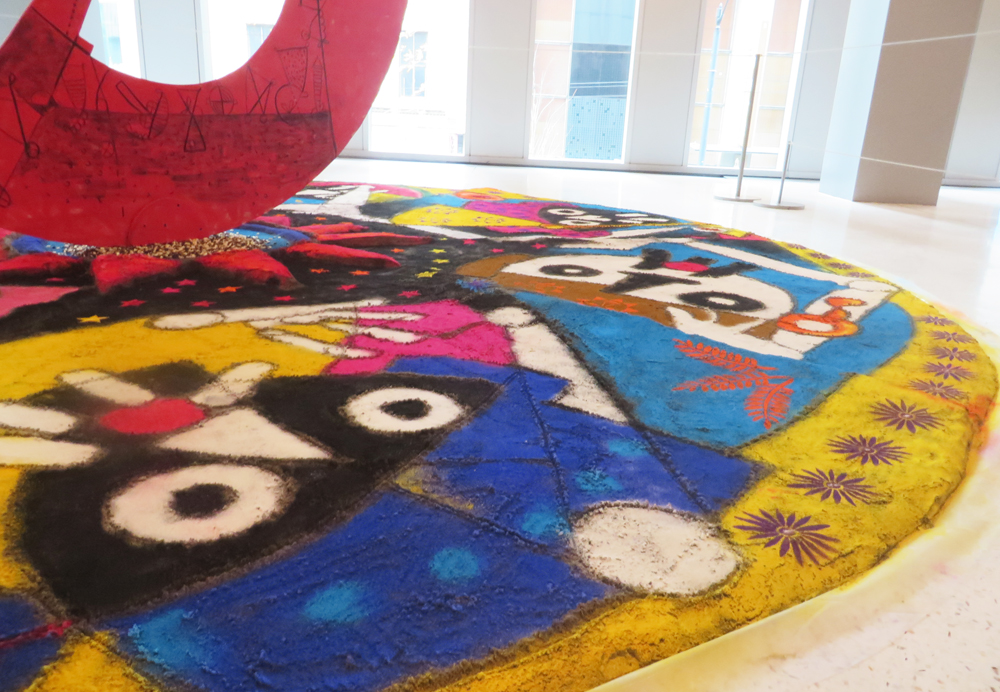
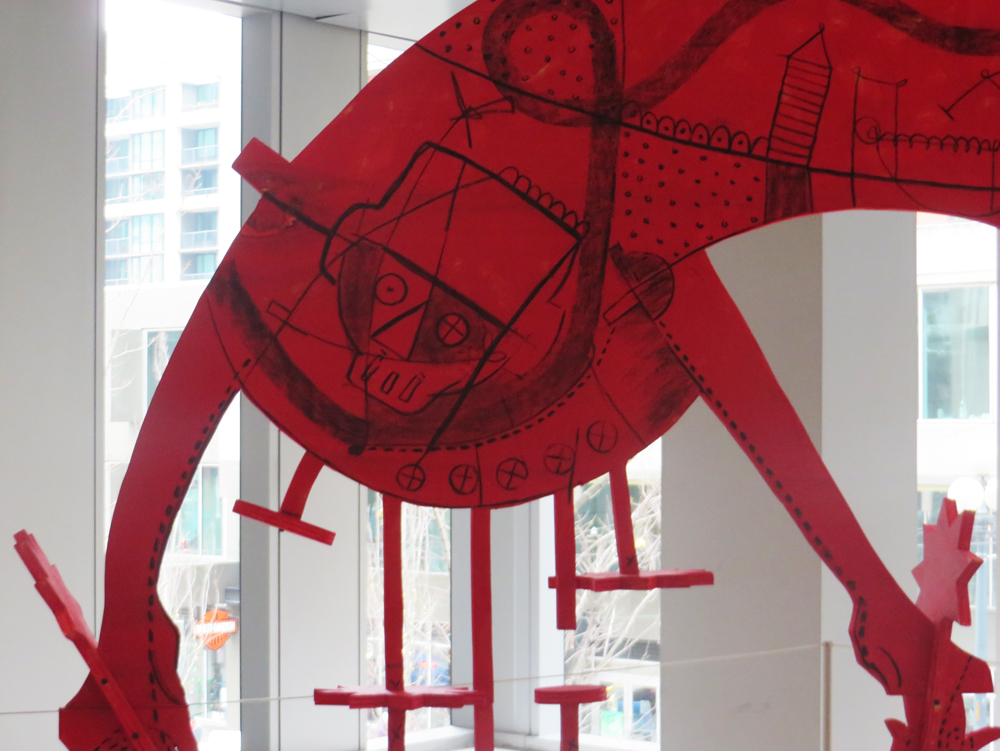 A holdover from their Day of the Dead celebration. Sand a bit dented, no less vivid.
A holdover from their Day of the Dead celebration. Sand a bit dented, no less vivid.
Because I grew up in the land of free museums, I tend to be kind of cheap with this sort of thing. (I’m trying to get over it.) So if I’d gone solo, there’s a very real possibility my skin-flinty ass would’ve skipped the Peru exhibit, as it costs extra. Fortunately, I was with wiser friends, and so we went for it.
A friend with a degree in museum studies once told me that if you find yourself putting panels full of words up, you actually want to write a book – not create a museum exhibit. The Peru exhibit has a bit of book-lust going on in its first couple of rooms – and indeed, there is a very large $65 book of the exhibit available in the gift shop. But bear with it and keep going, because the rest of the exhibit is fucking fascinating. In ways the ad campaign’s focus on ancient gold pieces can’t convey.
You’re probably going to hear jokes about sacrifices and blood and knives, and the first room doesn’t disappoint. It’s full of impeccably preserved vessels, some of which were indeed used for blood. Most of them have what’s described in the cards below – stirrup spouts.
 Thing one that I found fascinating about the exhibit was the early, early, early emphasis on the divine nature of the joining of the two sides of something. Two spouts, silver and gold, male and female. Two streams of blood, separated and rejoining. There’s an emphasis on complementing that is woven thickly throughout all the earliest art.
Thing one that I found fascinating about the exhibit was the early, early, early emphasis on the divine nature of the joining of the two sides of something. Two spouts, silver and gold, male and female. Two streams of blood, separated and rejoining. There’s an emphasis on complementing that is woven thickly throughout all the earliest art.
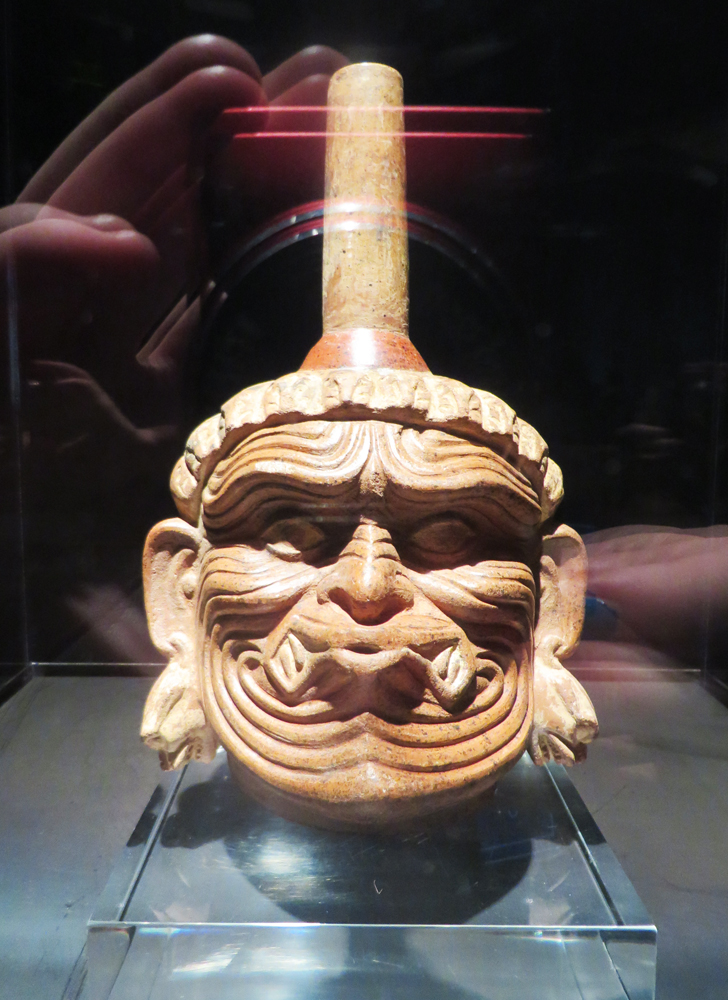 This is the Wrinkled Man. The card describes him as a Peruvian deity. The internet doesn’t give me much else to go on. Pity – this was one of my very favorite pieces.
This is the Wrinkled Man. The card describes him as a Peruvian deity. The internet doesn’t give me much else to go on. Pity – this was one of my very favorite pieces.
Now, of course, an exhibit like this doesn’t put in any old half-rotten artifact. Even so, Peru’s climate is apparently magic. Guess how old the feather panel below is. No, go on.
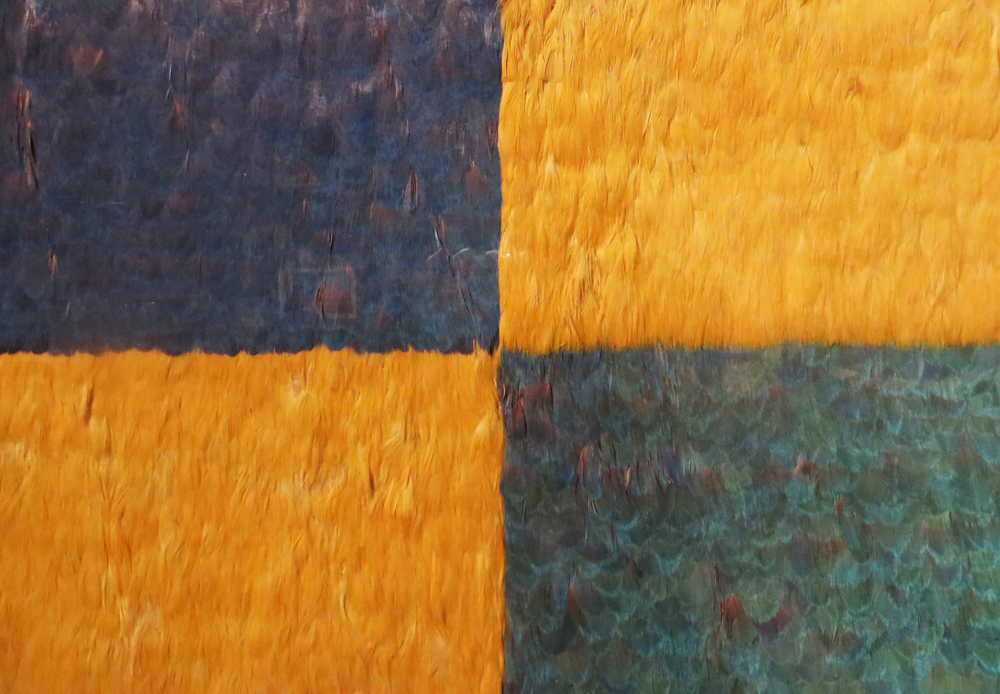 Did you say 1,000 to 1,400 years? I didn’t either.
Did you say 1,000 to 1,400 years? I didn’t either.
This panel was about six feet long and had cords on either end. I would wear this as a skirt. No question.
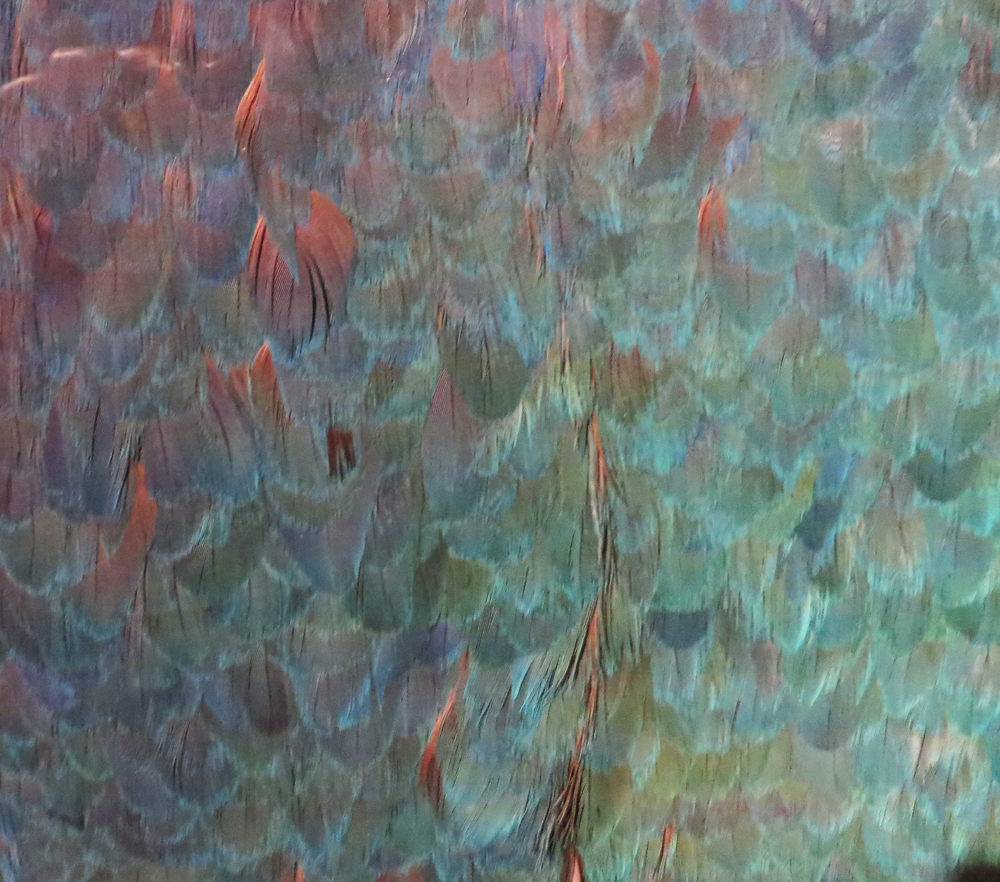 Millennium-old macaws. I think taxidermy is somewhere between gross and deeply upsetting. This, somehow, seems like a magical time capsule.
Millennium-old macaws. I think taxidermy is somewhere between gross and deeply upsetting. This, somehow, seems like a magical time capsule.
And that brings us to the end of our photo tour. As I have established, I am not a very daring photographer when faced with even mild authority. So when a guard informed me, as I leaned forward to take an unremarkable picture of a giant panel of woven fabric, that photography was not allowed… I stopped.*
So what’s after this?
Giant gold hands that were fitted on bodies in mummy bundles** as part of the burial ritual. The sharp and devastating change across all art once the bloody Spaniards arrived. The Cuzco school that integrated the elements of European religious art. The clear appropriation of local symbols into the presentation of Christian mythology. The stunning and somehow upsetting silver pelican, her beak and jointed tongue reaching toward her gold crest to peck open a wound to feed her silver-chased children with her blood during a famine. A much-copied image of two marriages, both Spanish men and Peruvian heiresses to titles, painted and repainted to be hung in churches throughout the country to emphasize the legitimacy of Spanish power.*** The intricate unfolding dioramas depicting layered Bible stories for the illiterate, done in the style and colors of Peru. And, in the last room, an effort to reintegrate, showing modern art by artists who championed a more local approach, pulling some of their ricocheting history back into their approach, but unable to shed what had happened.
It’s as vivid a timeline as I’ve ever seen.
At the beginning of the exhibit, in the should-have-been-a-book room, you’re introduced to Hiram Bingham III, Yale archeologist and model for Indiana Jones. Much of the pieces in the exhibit were unearthed by him and whisked back to New England. They were repatriated by Peru in 2006, and this is the first time they’ve been exhibited outside of Peru since then.
So I want to go to Peru now. One more for the list.
Anyway, you have until January. I hope you manage to get there. I hope you have a good couple of hours to walk through, wandering, bending close to see the unreal detail still on every urn and litter.
As for me… I’m asking for a SAM membership for Christmas.
*I don’t believe there was a sign up front, as I looked for one, and no other guard said anything I as leaned extremely close with my distinctly red camera, but hey, ok.
**That’s right, I said it. So did the audio tour.
***Even with the agenda, just the looks on the women’s faces. Shit.

